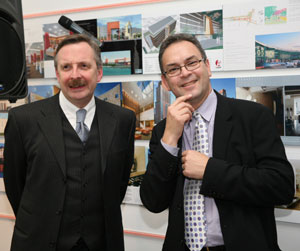by: Linda G. Miller
Event: Berlin-New York Dialogues: Cultural Kapital/Capital Kultur: Exhibition Symposium
Location: Center for Architecture, 11.10.07
Speakers: Illya Azaroff, Assoc. AIA — Director of Design, the design collective studio (NY); Markus Bader — Principal, raumlabor_berlin (Berlin); Susan Chin, FAIA — Assistant Commissioner of Capital Projects, NYC Department of Cultural Affairs (NY); Matthew Griffin, AA Dipl. Architekt — deadline > office for architectural services (Berlin); Regula Lüscher — State Department for Urban Development (Berlin); Kristien Ring — Director, German Center for Architecture (DAZ) (Berlin); Jochen Sandig — Producer & Cultural Administrator, Radialsystem V (Berlin); Ronald Shiffman, FAICP, Hon. AIA — Professor of Urban Planning, Graduate Center for Planning and Environment, Pratt Institute (NY); Claire Weisz, AIA — weisz + yoes architecture (NY); Lynnette Widder — Department of Architecture, Rhode Island School of Design; Peter Zlonicky — architect & planner (Munich)
Organizers: AIANY in collaboration with Deutsches Haus at New York University & Pratt Graduate Center for Planning and the Environment
Sponsors: Berlin-New York Dialogues presented in partnership with Carnegie Hall as part of Berlin in Lights festival; Underwriters: Digital Plus, RFR Holding; Patrons: Eurohypo, IULA-International Urban Landscape Award; Lead Sponsors: Carnegie Corporation of New York, Tishman Speyer Properties; Supporter: The German Consulate General New York; Friends: Aucapina Cabinetry, bartco Lighting, Getmapping, Osram Sylvania. This program is supported, in part, by public funds from the NYC Department of Cultural Affairs

At the Berlin-New York Dialogues Exhibition symposium, Consul General Dr. Hans-Jürgen Heimsoeth, with Rick Bell, FAIA, AIANY Executive Director.
Photograph by Sam Lahoz
The Mayor of Berlin, Klaus Wowereit, has said, “Berlin is a poor but sexy city.” It’s a city with a lot of space for people with little money. In fact, Berlin is as economically bankrupt as NYC was in the 1970s. This is the result of the building boom that the city experienced after reunification in 1990, as well as the unresolved issues arising from the shift of capital back to Berlin from Bonn in 1999.
NYC has recovered since the 1970s so much so that it supports 850 of the 1,400 public/private cultural institutions. Susan Chin, FAIA, assistant commissioner for capital projects at the NYC Department of Cultural Affairs (and former AIANY Chapter president) cited that city support has grown to $1.3 billion leveraging over $1 billion in private sector support to create arts and cultural facilities including the Bronx Museum of the Arts expansion by Arquitectonica, Metropolitan Museum of Art Leon Levy and Shelby White Court designed by Kevin Roche, FAIA, and the Queens Botanical Garden by BKSK Architects. The Department of City Planning is also rezoning 125th Street, river to river, for more cultural institutions to neighbor the Studio Museum of Harlem and Apollo Theater. In Long Island City, a cultural district is in formation with P.S. 1, the Noguchi Museum, and the Thalia Spanish Theatre.
The government in Berlin is not in a position to help private initiatives, but Berliners, with their “can-do” attitude have taken matters into their own hands. For example, a community turned the Post Bahnhof, a former postage distribution center, into a party and events space, transformed numerous abandoned storefronts into retail spaces, and courtyards into cafés and places to display art installations. Collective buildings are being developed that band together people with similar lifestyles. Inhabitants invest in and work with an architect to create a communal live/work space. Currently, there are more than 25 such projects in Berlin.
Berlin-based artists also are finding unlikely sites for temporary art. Jochen Sandig, co-founder of arts space Radialsystem V, created a place where contemporary and classical dance and music, and visual and electronic arts meet along the River Spree, taking advantage of the underutilized waterfront. During the demolition of the Palast der Republik, when the building was reduced to its core, architect Markus Bader of raumlabor_Berlin turned it into the Gasthof Bergkristall, a short-term hotel comprised of just four rooms.
Perhaps most comparable to new development in Berlin is the area of Red Hook, Brooklyn. Red Hook is a neighborhood with promise that could be on the road to gentrification, but still maintains a rich artistic culture. Both Berliners and New Yorkers express the need to put safeguards in place to keep rents down for the burgeoning artistic communities on both sides of the Atlantic in order to retain the cities’ vitality.
The Berlin-New York Dialogues is on view at the Center for Architecture through 01.26.07. See On View for more information.









